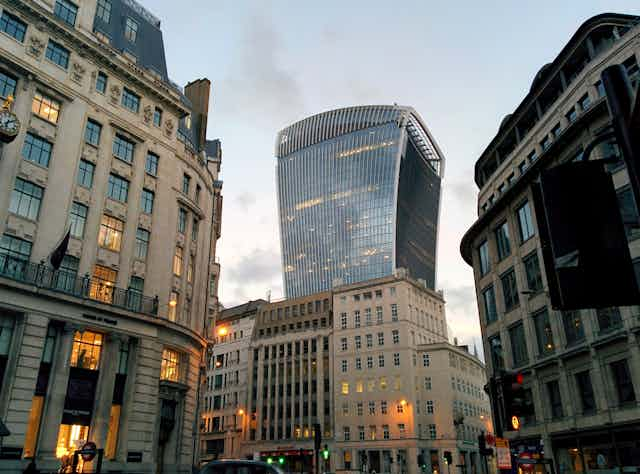Shocking new buildings often threaten to invade our cities. Sometimes, they simply land like alien spaceships, giving us very little warning. Foreign in form, colour and texture, these statement structures seem far removed from the reality of our daily lives. We feel they do not belong to our present; we know they are not related to our past. We moan and complain, and we suffer the sight of them. But we struggle to pin down exactly what makes them seem so “ugly” to us.
Indeed, the UK goes so far as to have an annual award for Britain’s worst building, called the Carbuncle Cup. The 2015 recipient – the Walkie Talkie building in London – was unanimously voted to be “the ugliest and most hated building in Britain”. The judges described it as “a gratuitous glass gargoyle graffitied on the skyline”. Strong words. So where do these sentiments come from?
In some ways, it’s down to human nature. We understand and perceive the world through the multiple stimuli we receive through our senses. When our environment changes naturally, at a slow pace, we have time to find ways of handling the new sensations and emotions that these changes trigger. For example, when the seasons change, we see changes in colour and vegetation, and our bodies adjust to cope with different levels of light and temperature.
But if environmental changes are too drastic or too rapid, or we’re exposed to a higher level of stimuli than what we can naturally cope with, then we can suffer from shock. Sudden changes can alter our heart beat, raise our blood pressure and increase our adrenaline levels, which ultimately takes its toll on our health and well-being. Research shows that when we’re forced to leave the environments we know and love – whether through displacement or dispossession – the upheaval can trigger what’s known as “root shock”.
Strong emotions

Given the strong emotional attachment we have to our neighbourhoods, it’s not surprising that we feel unsettled when unfamiliar buildings spring up on our skylines and disrupt the sights we’re used to seeing every day. What’s more, when communities are bound by particularly strong social ties, this can reduce our willingness to embrace new ideas and innovations, leading us to resist change.
But if human nature explains why we resist new and ambitious architecture, it can also account for how we grow to accept it. As social beings, our identities as individuals and as groups are defined by shared moral standards and social norms. To agree on and communicate these norms, we attribute social meaning to every component in our lives. We construct symbols, ideas, tastes, and preferences – what theorists have labelled “cultural capital”.
As a society changes, so does its cultural capital. Gradually the negative ideas we associate with shocking buildings can morph into something more positive. Once the “shock” factor has dissipated, these buildings have a chance to settle into the urban fabric. As our lives go on around them, they become part of the community’s collective memory. Charged with new symbolic values, the building we once hated might begin to reflect our dreams and aspirations. As we gradually become accustomed to it, we start to accept it and, eventually, even love it.
Tale as old as time
There are plenty of historic examples of this gradual shift from rejection to acceptance; from love to hate. The best-known case is perhaps the Eiffel Tower. When the plans were revealed back in 1887, local residents and artists signed a petition to protest against the “useless” and “monstrous” structure, labelling it the “dishonour” of Paris. But over the years, the tower became a symbol of love and romance, mystery and adventure. Today the building is one of the most renowned monuments in the world, packed with identity and meaning.

The same thing happened with Frank Lloyd Wright’s Guggenheim museum in New York. In 1946, building works were delayed by a decade when local residents and artists instigated a furious fight to prevent its construction. Initially, the design received an assortment of derogatory nicknames: “toilet bowl”, “potty”, “snail shell”, “marshmallow”, “corkscrew”, and – perhaps less searingly – “upside down washing machine”. Nevertheless, soon after completion, the museum became popular worldwide, partly due to its controversial appearance: a white purist form in a forest of glazed skyscrapers; a statement against the norm.
Of course, one can still question whether these buildings are worth the toll that they take on those with a strong emotional attachment to the locality. Some would say that it’s immoral for designers and developers to spend fortunes making personal statements at the expense of societal well-being. But others will argue that these bold gestures are the product of genius, and the driver of human progress.
Ultimately, architectural design is a matter of taste. It gives societies a licence to build up and tear down, to accept and reject, to love and to hate. Shocking buildings push our boundaries, they bring our identities and place emotions to the surface. They challenge our understanding of ourselves and our society, forcing us to evolve. They acclimatise our senses to the latest technological advances. They make us deal with the notion of a new reality. They make us confront our future.

